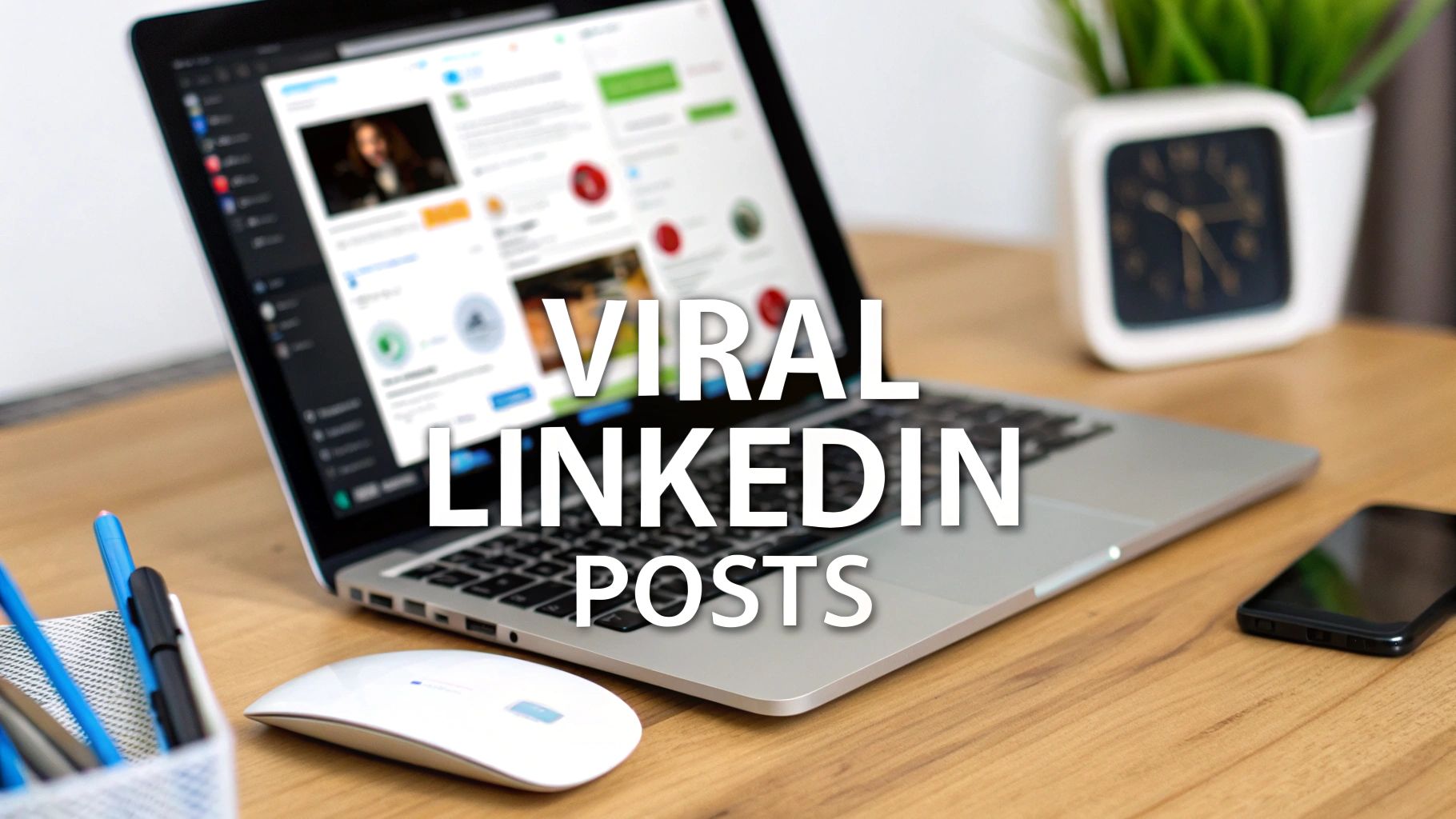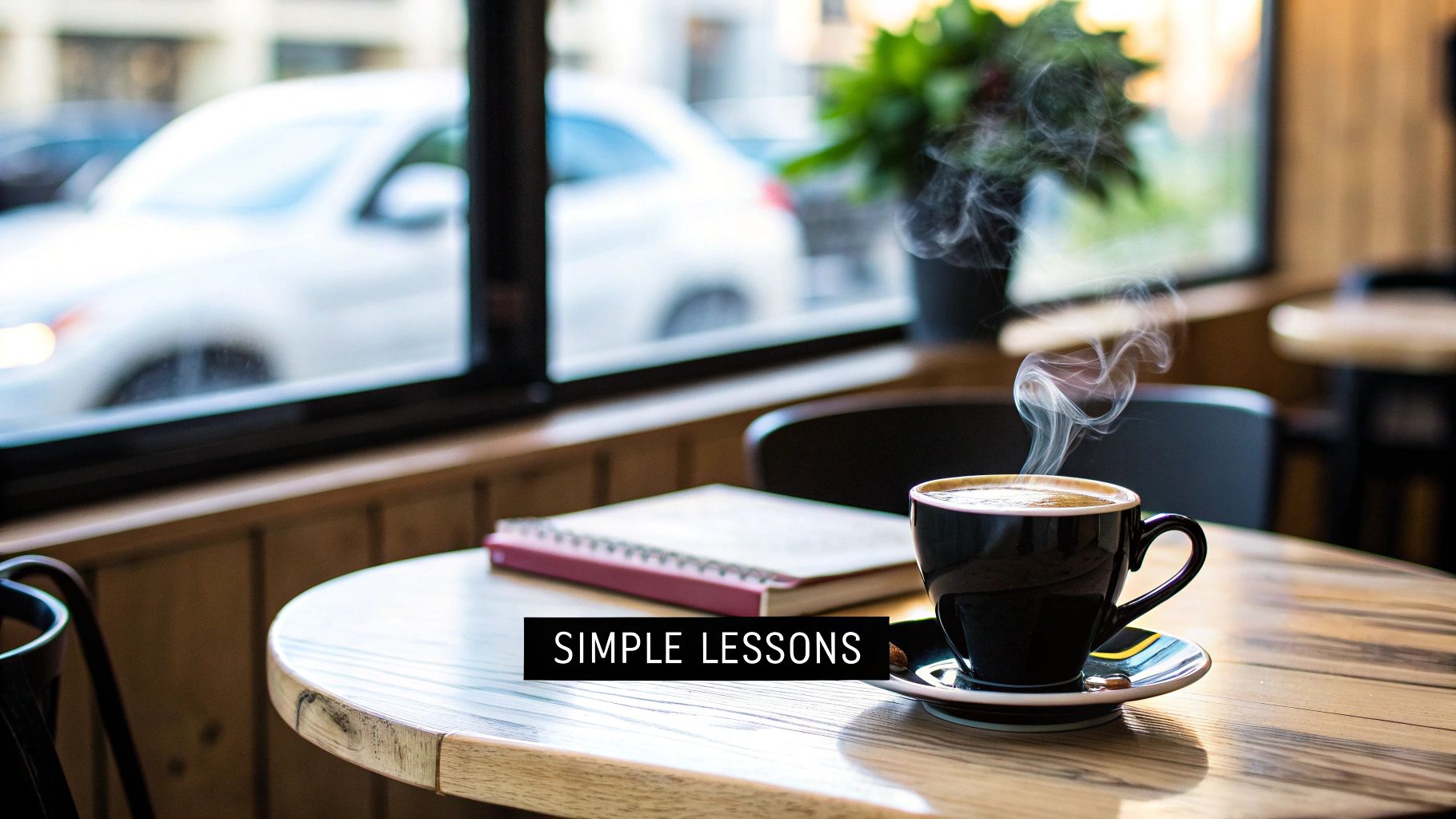
8 Types of Viral LinkedIn Posts to Use in 2025
Published on 2025-07-02
Everyone wants their content to go viral, but on LinkedIn, virality means more than just numbers. It translates to influence, opportunity, and tangible professional growth. While there's no single magic formula, there are proven patterns and frameworks that consistently capture attention and spark meaningful conversations. These are not just lucky shots in the dark; they are strategic content archetypes that tap into the core psychology of a professional audience.
In this comprehensive guide, we'll dissect 8 powerful types of viral LinkedIn posts that top creators have mastered. Forget generic advice like "be authentic" or "post consistently." We are diving deep into the specific structure, strategy, and subtle nuances that transform a simple update into a scroll-stopping phenomenon.
You will get actionable templates, see real-world examples, and learn the specific tactics needed to craft content that truly resonates. This guide provides the blueprints to build your personal brand, achieve massive reach, and create posts that don't just get seen-they get remembered and shared. We will explore the exact frameworks behind posts that deliver real results, from sharing vulnerable stories and controversial hot takes to data-driven insights and counterintuitive career advice. Let's get started.
1. The Vulnerability Story - Sharing Personal Failures
One of the most powerful strategies for creating viral LinkedIn posts is sharing a personal failure or struggle. This approach humanizes you, moving beyond the typical highlight reel of professional achievements. It works because it taps into a universal experience: everyone faces setbacks. By honestly sharing a story of failure, you create an immediate, authentic connection with your audience.

These posts resonate deeply because they are relatable and build trust. When you admit to a misstep, like a failed startup or a job rejection, you show that you've learned and grown. This authenticity is a refreshing change on a platform often filled with polished success stories, making your content stand out and encouraging engagement.
Why This Approach Goes Viral
Vulnerability signals strength, not weakness. A well-told story of failure demonstrates self-awareness, resilience, and a growth mindset, qualities highly respected in any professional field. This format encourages comments from others who have experienced similar challenges, creating a supportive and interactive thread. The engagement loop fuels the LinkedIn algorithm, pushing your post to a wider audience.
How to Implement This Strategy
Crafting a vulnerability post requires a careful balance. The goal is to be open without oversharing or appearing unprofessional.
- Focus on the Lesson: The story isn't just about the failure; it's about the takeaway. Clearly articulate what you learned from the experience and how it shaped you for the better.
- Structure Your Narrative: Start with a strong hook that captures the low point. Detail the struggle with specific, credible details. Conclude with the positive outcome, the lesson learned, or an inspirational message.
- Maintain Professional Boundaries: Share a professional failure, not a deeply personal one that is unrelated to your career. Keep the tone reflective and constructive, avoiding overly dramatic or complaining language.
- End with a Call to Action: Encourage others to share their own experiences. Ask a question like, "What's a failure that taught you an invaluable lesson?" This prompts comments and boosts engagement, a key ingredient for viral LinkedIn posts.
2. The Controversial Hot Take - Industry Contrarian Views
Another highly effective strategy for generating viral LinkedIn posts is to share a controversial or contrarian view on a common industry belief. This method works by disrupting the echo chamber and challenging the status quo. By presenting a well-reasoned "hot take," you spark intense debate and discussion, which the LinkedIn algorithm rewards with massive reach.

These posts, such as arguing that "remote work kills company culture" or that "hustle culture is toxic," immediately grab attention because they go against the grain. They invite professionals to either defend the conventional wisdom or join in challenging it. This dynamic creates a powerful engagement loop that can make your content spread like wildfire across the platform.
Why This Approach Goes Viral
Controversy, when handled correctly, creates dialogue. A strong contrarian opinion acts as a lightning rod for comments, shares, and reactions. People feel compelled to weigh in, either to agree with your bold stance or to refute it. This high level of engagement signals to LinkedIn that your post is valuable and relevant, prompting the algorithm to show it to a much broader audience of second and third-degree connections, a key factor in creating viral LinkedIn posts.
How to Implement This Strategy
A successful hot take is provocative but professional. It's about starting a thoughtful conversation, not an online argument.
- Back It Up: Don't just state an opinion. Support it with data, a personal experience, or a logical argument. Credibility is crucial to prevent your post from being dismissed as mere clickbait.
- Acknowledge the Other Side: Briefly mention the conventional viewpoint and why people hold it. This shows you've considered the topic deeply and makes your argument more balanced and persuasive.
- Stay Professional and Respectful: Your tone should be confident but not arrogant or dismissive. Be prepared to engage constructively with dissenting comments, showing respect for different perspectives.
- End with an Open-Ended Question: Prompt discussion by asking something like, "Am I wrong here? Tell me what you think," or "What has your experience been with this?" For more insights, you can learn how to write engaging LinkedIn posts on autoghostwriter.com.
3. The Success Story with Humble Beginnings
A classic narrative that consistently captures attention on LinkedIn is the "humble beginnings" success story. This type of post chronicles a journey from a challenging starting point to a place of significant professional achievement. Whether it's moving from a minimum-wage job to a six-figure salary or an immigrant finding success in a new country, these stories are incredibly inspiring because they showcase perseverance and prove that ambition can overcome adversity.

These underdog narratives work by creating a powerful emotional arc that audiences can invest in. They follow a relatable human journey of struggle, growth, and eventual triumph. By highlighting the contrast between the "before" and "after," you make your success feel more tangible and earned, which resonates far more than a simple post about your current accomplishments. This is a key strategy to build your personal brand on LinkedIn by grounding your achievements in an authentic and relatable context.
Why This Approach Goes Viral
This format taps into the universal appeal of an underdog story. People are naturally drawn to tales of overcoming obstacles, as it provides hope and motivation for their own journeys. When readers see that someone else has navigated a difficult path to success, they feel inspired and are more likely to engage by liking, commenting with encouragement, or sharing the post with their own networks. This high level of engagement signals to the LinkedIn algorithm that the content is valuable, leading to wider distribution and a shot at virality.
How to Implement This Strategy
To craft a compelling success story, you need to be authentic and focus on the journey, not just the destination.
- Be Specific with Details: Don't just say you started small; quantify it. Mention the specific job, the low salary, or the exact challenge you faced. Use a clear timeline to show the progression.
- Acknowledge Your Supporters: No one succeeds alone. Give credit to mentors, colleagues, or family members who helped you along the way. This adds humility and authenticity to your story.
- Focus on the Lessons: The story's power comes from the lessons learned during the struggle. What did the hard times teach you? How did early challenges prepare you for later success?
- End with Encouragement: Conclude your post with a message of hope for others who are on a similar path. Ask a question like, "What's the biggest obstacle you've overcome in your career?" to invite comments and turn your post into a source of inspiration, helping to create viral LinkedIn posts.
4. The Behind-the-Scenes Company Culture Post
Giving your network an authentic peek behind the curtain is a surefire way to build trust and generate buzz. These posts move beyond corporate announcements and showcase the real people and interactions that define your company culture. By sharing genuine moments, you offer an insider’s perspective on what it’s truly like to be part of your team.

This type of content, whether it's a team celebrating a major win, an employee spotlight, or a look at unique office perks, humanizes your brand. It attracts not just potential customers but also top talent looking for a workplace that aligns with their values. This authenticity makes for compelling viral LinkedIn posts that people are eager to engage with and share.
Why This Approach Goes Viral
People are inherently curious about the inner workings of companies they admire. Posts that highlight a positive and supportive culture resonate because they tap into the universal desire for a fulfilling work environment. When employees are featured, their own networks engage enthusiastically, creating a powerful ripple effect that expands the post's reach far beyond your company's followers. Companies like HubSpot and Salesforce have mastered this, turning their culture into a key marketing asset.
How to Implement This Strategy
Showcasing your culture effectively requires authenticity, not a staged photoshoot. The goal is to capture the genuine spirit of your organization.
- Feature Your People: Put the spotlight on your employees. Share their promotion announcements, work anniversaries, or stories about their impact. Tag them to encourage sharing within their networks.
- Show, Don't Just Tell: Instead of saying you have a great culture, show it. Post photos or videos of team-building activities, volunteer days, or even just a candid moment of collaboration in the office.
- Highlight Unique Values: Does your company offer unique benefits, support social causes, or have special traditions? Share these details to differentiate your workplace and attract like-minded individuals.
- Ask for Engagement: End your post with a question that invites conversation about workplace culture. Ask, "What's the most memorable team celebration you've been a part of?" to spark comments and drive visibility.
5. The Data-Driven Industry Insight
Another highly effective strategy for creating viral LinkedIn posts is to share valuable industry insights backed by compelling data. These posts move beyond simple opinions and provide concrete, actionable intelligence that professionals can use to make better decisions. By presenting surprising statistics, trend analyses, or data-backed predictions, you establish yourself as a credible authority in your field.
This type of content cuts through the noise because it offers genuine value. Professionals are constantly looking for an edge, whether it's understanding job market shifts, consumer behavior trends, or technology adoption rates. A post that delivers this information clearly and concisely is immediately shareable and highly engaging.
Why This Approach Goes Viral
Data-driven posts provide irrefutable proof of a concept, making them authoritative and trustworthy. When you present a surprising statistic or a well-researched trend, it sparks conversation and debate. Colleagues tag their managers, teams discuss the implications, and leaders share the insight across their networks. This high level of engagement and sharing signals to the LinkedIn algorithm that your content is valuable, boosting its visibility exponentially.
How to Implement This Strategy
To succeed with a data-driven post, you must present complex information in a simple, digestible way. Your analysis is just as important as the data itself.
- Cite Reputable Sources: Always use data from credible sources like academic studies, government reports, or respected market research firms. Mentioning your source builds trust.
- Explain the "So What?": Don't just present numbers; explain what they mean in practical terms. Connect the data directly to your audience's challenges or opportunities.
- Use Clear Visuals: Create simple charts, graphs, or infographics to make the data easy to understand at a glance. Visuals are highly shareable and break up text-heavy posts.
- Add Your Unique Perspective: The data is the foundation, but your unique analysis is what makes the post stand out. Offer your own predictions or actionable advice based on the findings. Integrating these insights into your content schedule is crucial for consistent impact; you can learn more about effective social media content planning on autoghostwriter.com.
6. The Unexpected Lesson from Everyday Situations
Another highly effective format for viral LinkedIn posts involves drawing profound business or life lessons from ordinary, everyday situations. This approach connects with readers by taking something familiar, like getting coffee or talking to a taxi driver, and revealing an unexpected insight. It works because it demonstrates an ability to find wisdom anywhere, making complex ideas accessible and relatable.
These posts are powerful because they reframe common experiences, encouraging the audience to see their own daily lives as a source of learning. By connecting a simple observation to a broader professional principle, like teamwork or leadership, you create a memorable "aha" moment for your reader. The content feels both original and deeply familiar, a combination that drives high engagement.
Why This Approach Goes Viral
People love stories, and they love learning. This format combines both in a package that is easy to digest and share. The relatability of the initial situation, whether it's an observation from a family dinner or an interaction at a grocery store, lowers the barrier to entry. The post doesn't feel like a lecture; it feels like a shared discovery. This narrative structure encourages comments where others share their own similar observations, sparking a conversation that the LinkedIn algorithm rewards with greater reach.
How to Implement This Strategy
To succeed with this format, the connection between the everyday event and the professional lesson must be clear, logical, and insightful.
- Start with a Relatable Scene: Use vivid, specific details to paint a picture of an everyday scenario. For example, describe the precise interaction you had with a barista who remembered your order.
- Draw a Clear Bridge: Explicitly connect the observation to a business concept. State, "This small act of personalized service is a masterclass in customer retention." Make the link impossible to miss.
- Focus on an Actionable Lesson: The takeaway should be practical. Don't just state the insight; explain how others can apply it in their professional lives. What specific action can they take based on your story?
- End with a Thought-Provoking Question: Prompt engagement by asking your audience to find lessons in their own lives. A great question might be, "What's the most surprising business lesson you've learned from an everyday situation?" This is a key step in creating viral LinkedIn posts.
7. The Appreciation and Recognition Post
Publicly celebrating the contributions of others is a powerful and often overlooked strategy for creating viral LinkedIn posts. These posts shine a spotlight on colleagues, mentors, or team members, acknowledging their hard work and positive impact. This approach fosters a sense of community and goodwill, creating a ripple effect of positivity.
Recognition posts are highly effective because they tap into a fundamental human desire to be seen and valued. By genuinely appreciating someone, you not only make that person feel good but also inspire your audience. People are naturally drawn to positivity, and this format encourages shares, likes, and comments from the recognized person's network, amplifying your reach significantly.
Why This Approach Goes Viral
Generosity is contagious. When you publicly praise someone, you create a feel-good moment that others want to be a part of. The person you tagged will likely engage and share the post, introducing it to their own professional circle. This creates a powerful network effect, as their connections join in to congratulate them, dramatically increasing the post's visibility and fueling the algorithm.
How to Implement This Strategy
A successful recognition post feels authentic and specific, not like a generic shout-out. The focus must remain entirely on the person you are appreciating.
- Be Hyper-Specific: Don't just say, "Thanks to Jane for being a great team member." Instead, detail a specific contribution: "A huge thank you to Jane Doe for single-handedly resolving the Q3 server migration issue, which saved the project from a major delay."
- Highlight Their Impact: Explain how their actions made a difference. Connect their work to a positive outcome for the team, the company, or your personal career growth. This adds weight and credibility to your praise.
- Use Genuine Language: Write from the heart. Avoid corporate jargon and use warm, sincere language that reflects your true appreciation. Authenticity is key to making the post resonate with a wider audience.
- Tag Everyone Involved: Make sure to tag the person or people you are recognizing. This notifies them directly and makes it easy for them and their network to see and engage with one of the most positive types of viral LinkedIn posts.
8. The Counterintuitive Career Advice
Challenging conventional wisdom is a surefire way to grab attention, and on LinkedIn, this translates into powerful, thought-provoking posts. The counterintuitive advice strategy involves presenting a career tip that seems to go against traditional thinking but is backed by solid logic and experience. It disrupts the echo chamber of common advice, making people stop, think, and reconsider their own professional journey.
Posts like "Why Saying No More Often Accelerates Growth" or "The Benefits of Being the 'Worst' Person on Your Team" are compelling because they offer a fresh perspective. They break the pattern of recycled tips, providing a unique viewpoint that prompts curiosity and discussion. This approach positions you as an insightful thought leader who sees beyond the obvious.
Why This Approach Goes Viral
Contrarian takes are inherently shareable. They create debate and encourage comments from people who either strongly agree or disagree, all of which signals high engagement to the LinkedIn algorithm. A well-argued counterintuitive post doesn't just offer advice; it starts a conversation. This format makes your content memorable and is a key driver for creating viral LinkedIn posts because it sparks intellectual curiosity and engagement.
How to Implement This Strategy
To succeed, your counterintuitive advice must be insightful, not just controversial for the sake of it. The key is to provide a logical and compelling argument that supports your unconventional stance.
- Start with a Bold Claim: Use a hook that directly challenges a common belief. For example, "Stop trying to find your passion. Here's what to do instead."
- Provide Clear Reasoning: Your post's body must explain the "why" behind your advice. Use logic, personal anecdotes, or case studies to build a convincing case and show your idea in action.
- Acknowledge the Nuance: Recognize that traditional advice isn't always wrong. You can mention when the conventional wisdom does apply to show a balanced perspective and add credibility to your argument.
- Prompt a Discussion: End by asking your audience what they think. A question like, "Have you ever quit a 'dream job' for something better? Share your story," invites participation and fuels the post's reach.
Viral LinkedIn Post Types Comparison
| Post Type | Implementation Complexity 🔄 | Resource Requirements ⚡ | Expected Outcomes 📊 | Ideal Use Cases 💡 | Key Advantages ⭐ |
|---|---|---|---|---|---|
| The Vulnerability Story - Sharing Personal Failures | Medium - requires careful personal storytelling and balance | Low - primarily personal reflection and writing | Builds trust, emotional connection, high engagement | Authentic connection, trust-building, personal branding | Deep emotional connection, credibility through authenticity |
| The Controversial Hot Take - Industry Contrarian Views | High - requires bold stance and data backing | Medium - research plus confident writing | Sparks debate, high engagement, positions as thought leader | Challenging norms, thought leadership, visibility | Generates debates, strong personal brand impact |
| The Success Story with Humble Beginnings | Medium - narrative with milestones and timeline | Low to medium - gathering details and storytelling | Inspires, attracts opportunities, builds aspirational brand | Motivational storytelling, credibility building | Motivational impact, aspirational sharing |
| The Behind-the-Scenes Company Culture Post | Medium - requires authentic visuals and storytelling | Medium to high - photos/videos and coordination | Strengthens employer brand, attracts talent, humanizes company | Employer branding, talent attraction, internal culture showcase | Builds employer brand, attracts talent |
| The Data-Driven Industry Insight | High - requires research, data analysis and visualization | High - data gathering, visualization expertise | Establishes thought leadership, attracts professionals | Sharing expert industry knowledge, data-driven marketing | High credibility, provides actionable insights |
| The Unexpected Lesson from Everyday Situations | Low to medium - creative storytelling required | Low - observational and writing skills | Highly relatable, memorable, encourages sharing | Creative insights, accessible wisdom for broad audiences | Relatable, memorable, practical wisdom |
| The Appreciation and Recognition Post | Low - gratitude-focused writing | Low - knowledge of colleagues’ contributions | Builds professional relationships, positive brand association | Employee recognition, positive culture promotion | Strengthens relationships, fosters positivity |
| The Counterintuitive Career Advice | Medium - requires nuance and clear logic | Low to medium - personal experience and explanation | Generates discussion, challenges norms, memorable content | Career development, innovative professional advice | Provides unique perspective, encourages reconsideration |
Putting the Viral Frameworks into Action
We've explored eight powerful frameworks for creating viral LinkedIn posts, from sharing vulnerable personal failures to offering counterintuitive career advice. Each strategy provides a unique blueprint for capturing attention and driving engagement. But understanding these templates is only the first half of the equation; consistent and authentic execution is what truly separates fleeting moments from sustained momentum.
The core lesson is this: viral LinkedIn posts are not a matter of luck. They are the result of strategic, deliberate effort. They are well-crafted pieces of content designed to connect with a specific human emotion, intellectual curiosity, or professional aspiration. The frameworks we've covered, whether it's the Controversial Hot Take or the Appreciation and Recognition Post, all hinge on two non-negotiable elements: authenticity and value. Your audience can spot a disingenuous post from a mile away.
From Theory to Tangible Results
So, how do you translate this knowledge into your next post? The key is to stop chasing virality for its own sake and start focusing on creating genuine connections. Virality is a byproduct of value, not the goal itself.
Here are your actionable next steps:
- Select One Framework to Master: Don't try to be a contrarian one day and a vulnerable storyteller the next. Pick one framework that feels most aligned with your personal brand or company voice and commit to experimenting with it for the next month.
- Commit to a Posting Cadence: Momentum on LinkedIn is built through consistency. Whether you post twice a week or five times a week, create a schedule and stick to it. This trains the algorithm and your audience to expect content from you.
- Analyze and Adapt: Pay close attention to your analytics. Which opening lines get the most "See more" clicks? Which topics generate the most comments versus likes? Use this data to refine your approach. A seemingly "failed" post is just a data point teaching you what your audience doesn't want.
The True Impact of Going Viral
Mastering the art of the viral LinkedIn post does more than just boost your ego with vanity metrics. It creates tangible business opportunities, builds an engaged community around your brand, and establishes you as a definitive authority in your field. It can attract top-tier talent, generate inbound leads, and open doors to partnerships you never thought possible. Each post is an opportunity to shape your professional narrative and build a powerful personal brand that works for you even when you're offline.
The path to creating viral content is a marathon, not a sprint. It requires patience, experimentation, and a genuine desire to serve your audience. By applying these proven frameworks, you move from guessing what might work to knowing what will connect. The next viral LinkedIn post isn't some far-off dream; it's waiting for you to write it. Start today.
Ready to stop guessing and start creating high-impact content? The templates and frameworks we've discussed are built directly into autoghostwriter. Use our AI-powered tools to instantly generate post ideas, craft compelling narratives, and apply proven viral structures to your content in seconds. Try autoghostwriter and accelerate your journey to becoming a LinkedIn authority.